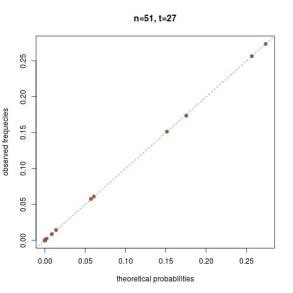Feller’s shoes and Rasmus’ socks [well, Karl’s actually…]
Want to share your content on R-bloggers? click here if you have a blog, or here if you don't.
 Yesterday, Rasmus Bååth [of puppies’ fame!] posted a very nice blog using ABC to derive the posterior distribution of the total number of socks in the laundry when only pulling out orphan socks and no pair at all in the first eleven draws. Maybe not the most pressing issue for Bayesian inference in the era of Big data but still a challenge of sorts!
Yesterday, Rasmus Bååth [of puppies’ fame!] posted a very nice blog using ABC to derive the posterior distribution of the total number of socks in the laundry when only pulling out orphan socks and no pair at all in the first eleven draws. Maybe not the most pressing issue for Bayesian inference in the era of Big data but still a challenge of sorts!
Rasmus set a prior on the total number m of socks, a negative Binomial Neg(15,1/3) distribution, and another prior of the proportion of socks that come by pairs, a Beta B(15,2) distribution, then simulated pseudo-data by picking eleven socks at random, and at last applied ABC (in Rubin’s 1984 sense) by waiting for the observed event, i.e. only orphans and no pair [of socks]. Brilliant!
The overall simplicity of the problem set me wondering about an alternative solution using the likelihood. Cannot be that hard, can it?! After a few computations rejected by opposing them to experimental frequencies, I put the problem on hold until I was back home and with access to my Feller volume 1, one of the few [math] books I keep at home… As I was convinced one of the exercises in Chapter II would cover this case. After checking, I found a partial solution, namely Exercice 26:
A closet contains n pairs of shoes. If 2r shoes are chosen at random (with 2r
This is not exactly a solution, but rather a problem, however it leads to the value
as the probability of obtaining j pairs among those 2r shoes. Which also works for an odd number t of shoes:
as I checked against my large simulations.  So I solved Exercise 26 in Feller volume 1 (!), but not Rasmus’ problem, since there are those orphan socks on top of the pairs. If one draws 11 socks out of m socks made of f orphans and g pairs, with f+2g=m, the number k of socks from the orphan group is an hypergeometric H(11,m,f) rv and the probability to observe 11 orphan socks total (either from the orphan or from the paired groups) is thus the marginal over all possible values of f:
So I solved Exercise 26 in Feller volume 1 (!), but not Rasmus’ problem, since there are those orphan socks on top of the pairs. If one draws 11 socks out of m socks made of f orphans and g pairs, with f+2g=m, the number k of socks from the orphan group is an hypergeometric H(11,m,f) rv and the probability to observe 11 orphan socks total (either from the orphan or from the paired groups) is thus the marginal over all possible values of f:
so it could be argued that we are facing a closed-form likelihood problem. Even though it presumably took me longer to achieve this formula than for Rasmus to run his exact ABC code!
Filed under: Books, Kids, R, Statistics, University life Tagged: ABC, capture-recapture, combinatorics, subjective prior, William Feller
R-bloggers.com offers daily e-mail updates about R news and tutorials about learning R and many other topics. Click here if you're looking to post or find an R/data-science job.
Want to share your content on R-bloggers? click here if you have a blog, or here if you don't.
